We may not have the course you’re looking for. If you enquire or give us a call on +44 1344 203 999 and speak to our training experts, we may still be able to help with your training requirements.
We ensure quality, budget-alignment, and timely delivery by our expert instructors.
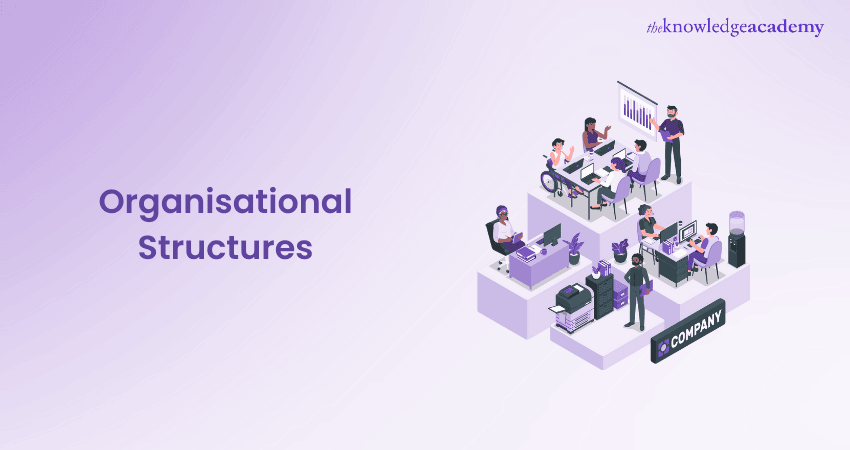
Have you ever wondered how organisations work and how they decide who does what? The answer is Organisational Structure, as it designs how an organisation is organised. It helps organisations work smoothly and be successful in what they do.
In this blog on Organisational Structure, we will look at the different types of structures, the essential functions they serve, and the roles people play within them.
Table of Contents
1) What is an Organisational Structure?
2) Types of Organisational Structures
3) Centralised vs Decentralised Organisational Structures
4) Functions of Organisational Structures
5) Roles within Organisational Structures
6) Conclusion
What is an Organisational Structure?
An Organisational Structure is a plan that shows how a company organises its work to achieve its goals. It lays out parameters like rules, jobs, and who is responsible for what. The structure also shows how information moves through the company.
For example, in a centralised system, big decisions come from the top and go down. In a decentralised system, decision-making power is spread out across different levels of the organisation. A successful Organisational Structure outlines the responsibilities of every Employee and how these roles contribute to the overall system.
Types of Organisational Structures
Organisations come in different shapes and sizes, and the choice of an appropriate structure can significantly impact how they function. Discussed below are some of the most common types of Organisational Structures:
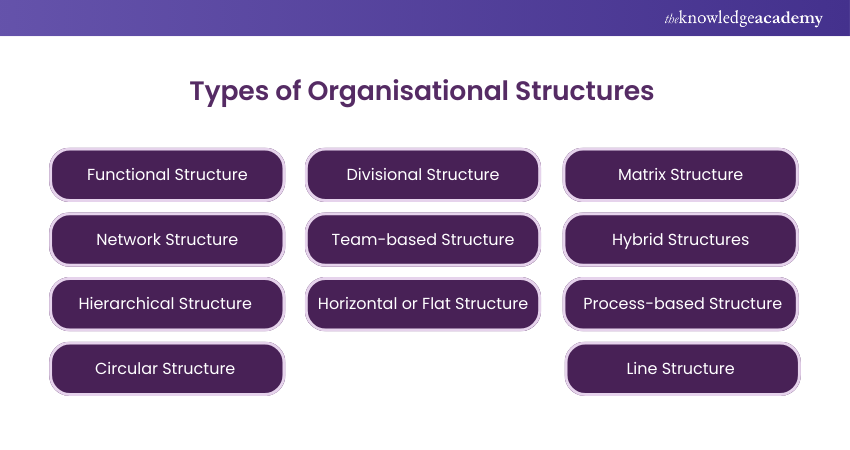
Functional Structure
In a Functional Structure, a company organises its employees into groups based on their specific skills or functions, like Marketing, finance, or Human Resources. Each group is led by a manager who's an expert in that field. This structure ensures everyone knows their role and who they report to, creating a clear chain of command.
It improves efficiency as people become specialists in their areas. However, it can sometimes lead to miscommunication between different parts of the company, making it a bit like separate islands in a big sea.
Learn change management strategies with our Managing Organisational Change Effectively – Join today!
Divisional Structure
A Divisional Structure is an organisational design where a company is divided into separate units, or divisions, based on specific criteria. These criteria can be
a) product lines,
b) geographic regions,
c) customer segments, or
d) any other relevant factors.
Each division operates somewhat independently, having its own set of functional departments, such as marketing, finance, and operations. This Structure allows divisions to focus on their unique needs and challenges. They often have their own management teams responsible for the division's success.
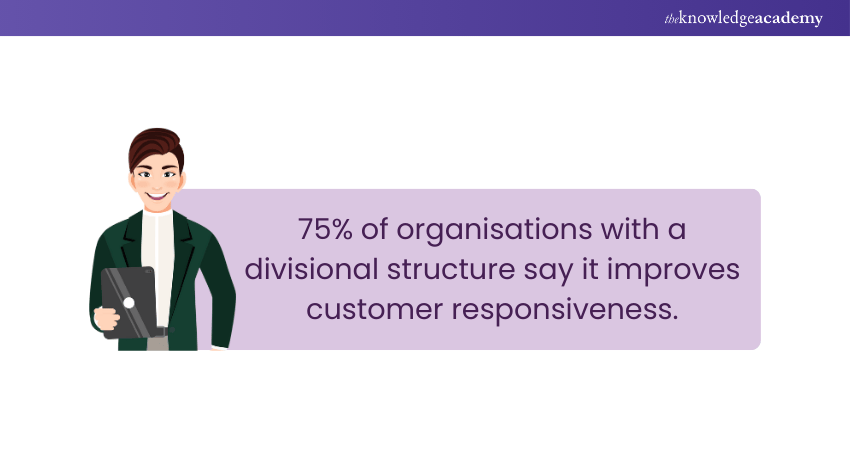
The advantages of a Divisional Structure include:
a) Adaptability
b) Responsiveness to market or product needs
c) Improves accountability of Divisional Managers
Matrix Structure
A Matrix Structure is a complex organisational framework that combines elements of both functional and divisional structures. In this structure, employees maintain dual reporting relationships. They report to both their Functional Manager and Divisional Manager.
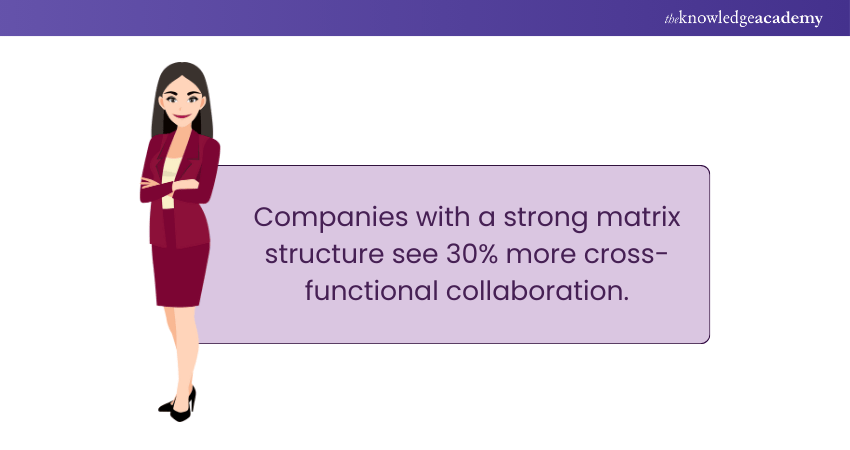
a) Functional Manager oversees employees' skill-based performance and their project.
b) Divisional Manager supervises employee’s work on specific projects or in a particular division.
Matrix Structure promotes
a) Cross-functional collaboration,
b) Skill-sharing, and
c) Efficient resource allocation
However, it can also be challenging to manage due to the potential for power struggles and conflicts between managers. Effective Communication and dispute resolution skills are essential for its success.
Understand the change management tool even better through our expert-led Complete Complete Change Management Assessments Training. Sign up now!
Network Structure
Network Structure is an organisational design that emphasises external partnerships and collaboration. Instead of maintaining large internal departments, this structure relies on a network of external entities, including suppliers, contractors, and business partners, to carry out various functions and activities.
In this structure, the core organisation remains relatively small and focuses on its primary activities, while outsourcing a significant portion of its tasks. This allows the organisation to stay agile and adaptable, as it can quickly scale its operations up or down as needed.
Team-based Structure
A Team-based Structure is an organisational setup where the company is divided into small teams. Each small team is responsible for specific tasks or projects. These teams are cross-functional, meaning they include people with various skills and expertise needed for their assignments. Unlike traditional hierarchies, team members often have a say in decision-making, and they collaborate closely to achieve their common goals.
Team-based Structures are known for their adaptability and responsiveness. They are particularly effective in dynamic and rapidly changing industries where innovation and quick decision-making are crucial. When implemented successfully, Team-Based Structures can improve creativity, Employee Engagement, and improved Problem-solving.
Hybrid Structures
Hybrid Structures brings elements from various types of Organisational Structures together to create a unique design. These structures aim to capitalise on the strengths of different traditional models while mitigating their weaknesses. By combining features from functional, divisional, matrix, and other structures, hybrid structures offer organisations flexibility and adaptability to address their unique requirements.
Hybrid Structures often demand careful planning and a fine-tuned integration process to ensure the elements work together effectively. They can adapt to different functions or projects, promoting creativity and innovation while maintaining essential hierarchical oversight
Hierarchical Structure
A Hierarchical Structure looks like a pyramid, with the highest authority at the top and employees organised into levels below. Each level has a clear chain of command, with managers overseeing their teams. This structure works well for large organisations that need clear roles and responsibilities.
It encourages order and efficiency, but decision-making can be slow as ideas must go through multiple levels. Employees may feel less connected to higher management. It's a common structure in industries like government and large corporations.
Horizontal or Flat Structure
A Flat Structure has fewer management levels, giving employees more autonomy and decision-making power. It promotes open communication and teamwork, as everyone works closely together. This structure suits small businesses or startups with collaborative cultures.
Decision-making is faster, but the lack of hierarchy can sometimes create confusion about roles. It's ideal for organisations that prioritise flexibility and innovation. However, as the company grows, managing without hierarchy can become challenging.
Process-based Structure
A Process-based Structure focuses on workflows or processes rather than departments. Teams are formed based on specific tasks or projects, which helps improve efficiency and accountability. It’s ideal for companies that rely on standardised procedures, like manufacturing firms.
This structure allows for better focus on customer needs and smoother operations. However, employees might feel restricted to repetitive tasks. It works well when the company’s success depends on optimising processes.
Circular Structure
A Circular Structure places Leadership in the centre, with teams and departments organised in rings around them. It promotes open communication and collaboration, making everyone feel included. Instead of strict levels, ideas flow more freely in all directions.
This structure works well for creative organisations or those that value teamwork. However, it can sometimes create confusion about who makes final decisions. It’s less common but useful for businesses that prioritise innovation.
Line Structure
A Line Structure is simple and straightforward, with direct relationships between managers and employees. Authority flows directly from the top to the bottom. It’s easy to understand and works well for small organisations or those with clear, routine tasks.
This structure allows for quick decision-making and accountability. However, it can limit collaboration between departments. It’s often used in military or small business settings.
Master Your Interview with top Change Management Interview Questions – Prepare Now!
Centralised vs Decentralised Organisational Structures
Here are the key differences:
Decision-making
a) Centralised: Top managers make decisions, and employees follow instructions. Workers have little say in how decisions are made.
b) Decentralised: Decisions are made by teams or departments. Employees have more control over their work.
Speed
a) Centralised: Decisions take longer because they need approval from higher management. This can slow things down in urgent situations.
b) Decentralised: Decisions are made faster because teams can act quickly. This is useful in situations that need quick action.
Employee Involvement
a) Centralised: Employees mostly follow orders and don’t help make decisions. This can make them feel less motivated.
b) Decentralised: Employees are involved in decisions and feel valued. They can share their ideas and opinions.
Control and Consistency
a) Centralised: The company follows the same rules and policies everywhere. This makes things more organised and predictable.
b) Decentralised: Teams can change how they work to fit local needs. This gives more freedom but may create differences in how things are done.
Suitability
a) Centralised: Best for small companies or businesses that need strong control. It works well when decisions must follow one clear direction.
b) Decentralised: Ideal for large organisations or those in different locations. It helps them handle local problems better.
Functions of Organisational Structures
The functions of Organisational Structures influence the way an organisation operates and achieves its goals. Given below are the four main functions of Organisational Structures.
Hierarchy and Chain of Command
One of the primary functions of Organisational Structures is to establish a clear hierarchy and chain of command. In simpler terms, this means defining who reports to whom. A hierarchy ensures that every employee knows their place in the organisation and understands who they should report to for guidance, decision-making, and accountability.
The hierarchy starts at the top with top-level management, such as CEOs and executives, and trickles down through middle-level management and front-line management to non-managerial employees. This chain of command streamlines the Decision-making Processes and sets the direction of the organisation.
Specialisation
Another crucial function is specialisation. Different Organisational Structures promote varying degrees of specialisation. In Functional Structures, employees are grouped based on their areas of expertise, which fosters deep knowledge and specialisation in specific functions, such as marketing, finance, or operations.
Specialisation allows employees to become experts in their respective fields. It can lead to increased efficiency and high-quality work. It also enables the organisation to take advantage of the best talent in each area.
Coordination
Effective coordination is vital for the smooth operation of an organisation. Different functions and departments must work together seamlessly to achieve common goals. The chosen Organisational Structure greatly impacts how coordination is managed.
For instance, Functional Structure may struggle with inter-departmental coordination, as each department operates somewhat independently. In contrast, Matrix Structure promotes cross-functional coordination but requires robust communication and collaboration mechanisms to manage complex projects and initiatives.
Communication
Organisational Structures play a significant role in shaping how information flows within an organisation. For example, Functional Structures tend to have clear communication paths within departments but may lack communication between them. Matrix Structures facilitate cross-functional communication due to their collaborative nature, but they also face challenges related to multiple reporting lines and potential conflicts.
The choice of Organisational Structure can either promote open and transparent communication or create bottlenecks that disrupt the flow of information. Therefore, an organisation must carefully consider its communication needs when selecting a structure that aligns with its goals and objectives.
Learn the methods to drive change initiatives in organisations with our Change Management Foundation & Practitioner Course – Join today!
Roles Within Organisational Structures
Roles within Organisational Structures are essential to ensure that an organisation operates smoothly, and its goals are achieved. These roles can vary depending on the types of Organisational Structure in place.
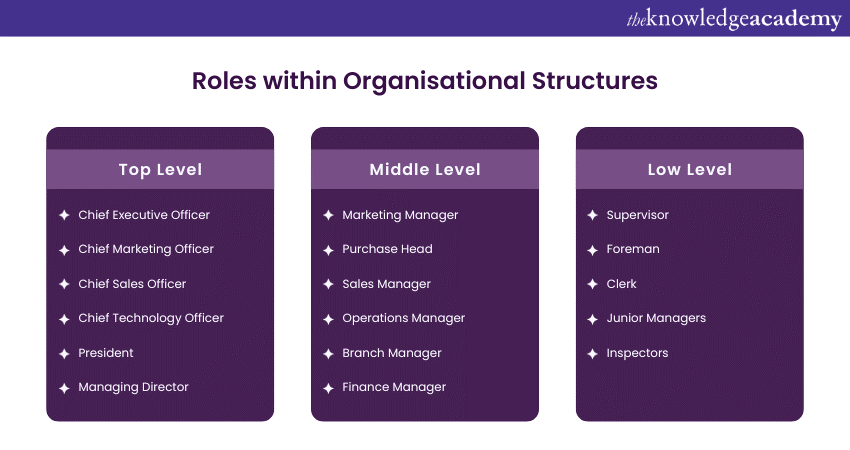
Top-level Management
Top-level management, also referred to as the C-suite, comprises executives like the
a) CEO (Chief Executive Officer),
b) CFO (Chief Financial Officer),
c) COO (Chief Operating Officer), and others.
Their primary responsibility is to set the organisation's strategic direction, establish long-term goals, and make high-level decisions that guide the entire organisation. Top-level managers are accountable for the overall success and performance of the company.
Middle-level Management
Middle-level managers bridge the gap between top-level management and front-line employees. They include positions like
a) Department Heads
b) Regional Managers
c) Branch Managers
Their role involves translating the high-level strategies and objectives into actionable plans. Middle-level managers coordinate various departments or divisions, ensuring that the organisation's strategies are effectively implemented. They play a crucial role in Decision-Making, resource allocation, and performance evaluation.
Front-line Management
Front-line managers are responsible for overseeing the day-to-day operations of specific departments, teams, or projects. They are in direct contact with non-managerial employees, ensuring that tasks are carried forward efficiently and according to Organisational guidelines. Front-line Managers often manage various things to achieve specific operational goals such as:
a) employee schedules
b) allocate resources
c) monitor progress
Non-managerial Employees
Non-managerial employees, often referred to as staff or individual contributors, form the backbone of the organisation. They perform various tasks, including producing goods, providing services, conducting research, and more. Their roles are specialised based on their skills and expertise, and they are responsible for executing the organisation's daily functions.
Conclusion
An Organisational Structure is key to making sure work is organised and goals are met. Choosing the right structure helps teams understand their roles, improves communication, and supports better decision-making. Understanding these basics can help any organisation work more smoothly and achieve long-term success.
Learn organisational techniques with our Organisational Skills Training – Join today!
Frequently Asked Questions
What are the key Elements of an Organisational Structure?

The key elements include roles, responsibilities, and how tasks are divided and coordinated. It also shows the chain of command and how decisions are made in the organisation.
What is an Organisational Structure Example?

An example is a Hierarchical Structure, where managers lead teams, and decisions flow from top to bottom. Another example is a Flat Structure, where employees work together with fewer levels of management.
What are the Other Resources and Offers Provided by The Knowledge Academy?

The Knowledge Academy takes global learning to new heights, offering over 3,000 online courses across 490+ locations in 190+ countries. This expansive reach ensures accessibility and convenience for learners worldwide.
Alongside our diverse Online Course Catalogue, encompassing 19 major categories, we go the extra mile by providing a plethora of free educational Online Resources like News updates, Blogs, videos, webinars, and interview questions. Tailoring learning experiences further, professionals can maximise value with customisable Course Bundles of TKA.
What is The Knowledge Pass, and How Does it Work?

The Knowledge Academy’s Knowledge Pass, a prepaid voucher, adds another layer of flexibility, allowing course bookings over a 12-month period. Join us on a journey where education knows no bounds.
What are Related Courses and Blogs Provided by The Knowledge Academy?

The Knowledge Academy offers various Change Management Certification, including the Change Management Practitioner Course, Change Management Foundation & Practitioner Course, and Managing Organisational Change Effectively. These courses cater to different skill levels, providing comprehensive insights into Top 10 Organisational Change Models.
Our Project Management Blogs cover a range of topics related to Organisational Structures, offering valuable resources, best practices, and industry insights. Whether you are a beginner or looking to advance your Organisational Structures skills, The Knowledge Academy's diverse courses and informative blogs have got you covered.
Upcoming Project Management Resources Batches & Dates
Date
 Introduction to Project Management Course
Introduction to Project Management Course
Fri 14th Feb 2025
Fri 14th Mar 2025
Fri 9th May 2025
Fri 15th Aug 2025
Fri 10th Oct 2025
Fri 12th Dec 2025






 Top Rated Course
Top Rated Course



 If you wish to make any changes to your course, please
If you wish to make any changes to your course, please


